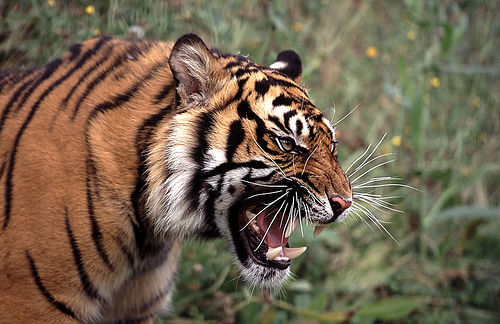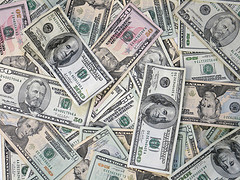| Chapter 5 |
| A Realistic View of Litigation |

This work is licensed under a Creative Commons Attribution-Noncommercial-Share Alike 3.0 United States License. |
| This chapter will cover how copyright litigation usually works in the real world - a lot of snarling and sometimes a big bite. But mostly a lot of growling. Our goal is to better understand the litigation scene so you and I can make more accurate evaluations of the risks and probabilities of success as we encounter potential infringement claims in the future. |
| Part II � What Can Happen to a Copyright Infringer? |
| Copyright law provides a range of remedies and penalties for those who violate the exclusive copyrights. These remedies include damages (i.e. an order to pay money to the copyright owner) and equitable remedies (such as destruction of infringing copies). First, let�s discuss damages. For specific illustrations, we return to the fierce rivals Annie Author and Wendy Wordsmith, and assume that Wendy has indeed infringed Annie�s copyright in her novel. |
| Since Wendy infringed Annie's copyright, Annie has one of two options for what she can claim from Wendy. Option number one is an amount of money to cover any loss she suffered as a result of the infringement PLUS the infringer�s profits that arose from the infringing action. This allows the copyright owner to be restored to the position she would have been but for the infringement and also strips the infringer of any ill-gotten gains. |
| Option two is called statutory damages. Basically it is a set amount a copyright owner can receive whether or not she suffered any actual damages. The idea behind statutory damages is that it can be difficult for a copyright owner to show all the ways in which she was harmed. If she can't show damages, she won't have any protection. With statutory damages, she can receive a sum to ensure that her work is adequately protected. This probably won't match up to her actual damages, but at least she gets something. It is a compromise Congress made to preserve the incentive to create. |
| Copyright law sets the amount at �a sum of not less than $750 or more than $30,000 as the court considers just.� The judge, based on the facts before him, sets the amount which will produce, in his opinion, a fair result. So even if an infringer has caused no harm to a copyright holder, she can still be on the hook for a considerable amount of money. In addition, if a court finds that the infringement was �willful,� (when the infringer knew he would infringe but did it anyway) the court can increase the statutory damages up to $150,000. The court also has discretion to award attorney�s fees on top of the damages. This can add up to a lot of money. These provisions of the copyright law are intended to ensure that a copyrighted work is adequately protected. |
| The statute also creates room for honest users and creators. For example, if an infringer can show that she had no reason to believe her acts were copyright infringement, the court can reduce the amount of statutory damages to $200. A judge has discretion in these situations to define the specific amounts. The copyright owner can still elect actual damages, but in many cases this will be a trivial amount. In addition, a judge can waive statutory damages for individuals working for a nonprofit educational institution or similar entities. |
| In other words, if you are honestly trying to obey the copyright laws, then the fear of statutory damages should not be a large deterrent to creative activity (although there may be other significant factors to consider). For an example, consider the case of Terry Teacher, who used Annie's work in chapter 2 and assume his use was not fair but infringing. Because Terry had a reasonable belief his use was fair, and because he is a teacher in a nonprofit educational institution, a judge will likely waive statutory damages. Annie will have to prove actual damages, which will probably be zero. At the end of the day, even though Terry infringed Annie's copyright, he will probably have to pay $0 to Annie - that's a big difference from the millions of dollars we see in the headlines. In this situation copyright law lowers the potential penalties because teaching and fair use are so important to the purpose of copyright law. Copyright law shouldn't scare away anyone from spreading knowledge - that would frustrate the entire purpose of copyright! |
| In summary, copyright law is designed to repair any harm suffered by the copyright owner. In cases where the copyright owner is barely harmed, or the infringer was trying her best to obey the laws, any damage award is designed to be minimal. Congress strikes a balance between protecting copyrighted works and allowing good faith users to contribute their uses to the good of society. |
 |
| Image provided by GavinBell. |
 |
| Image by Tracy O. |
| Part II - What Else Can Happen to a Copyright Infringer? |
| Part I - How Does Litigation Work? |
| There are also consequences for copyright infringement that don't directly deal with money. For example, a court can issue an injunction - an command ordering the infringer to cease all infringing activites. This is a powerful tool because anyone who violates an injunction will be in contempt of court and may be sent to jail. Injunctions are frequently issued against copyright infringers to protect the economic interests of the copyright holder. |
| In addition, a judge can order the impoundment and destruction of all infringing material. Again, this is to preserve the economic incentive to create and also to prevent any unjust enrichment by an infringer. These remedies are only available once infringement has been proven in court. |
| The first thing a copyright owner usually does (after registering the copyright, of course) is file a "cease and desist" letter. In essence, this letter tells the other party to stop infringing the copyright. There are lots of different ways to construct this letter depending on what message you want to send out. Many times copyright owners send nasty letters to intimidate or scare the other party. They perceive the other side as a competitor or opponent and want to show a strong arm to force a quick settlement in their favor. While this may seem like an effective way to protect your copyright, there are drawbacks to this plan. First, a hostile approach almost always provokes a hostile response. If the party is someone with whom you hope to do business (i.e. license your work) then it may be wiser to use a softer approach. Second, with the advent of the internet, there is a good chance your letter will be posted all over the web. If you come across as a jerk, your public image and reputation will suffer - not to mention any future business prospects. Carefully consider how your move will appear to your current and future customers and business partners. It might be helpful to consult a public relations firm if you feel you are on thin ice. |
| Following this first letter will be a series of correspondence which will go back and forth between the parties. Or, more accurately, between their lawyers. At this stage, there is some strategy and risk-management. As we all know, lawyers and lawsuits are not cheap. Sometimes it is easier to enter a licensing agreement than to litigate - even if you are sure you will prevail. At the same time, there are benefits to having the matter settled in court, such as precedent (if you settle with one, more may come) or the satisfaction of knowing the "free-riding scumbag" or "greedy copyright owner" didn't get anything from you. I recommend evaluating your circumstances and risk aversion to determine what path is right for you. If you own or use a website, then Richard Keyt has some solid advice about copyright infringement on the web. Even if you don't have a website, I suggest reading his material - many of his points apply to any creative work. In particular, he makes some good points about registering your website and points out the pros and cons to cease and desist letters. Even more important in the digital age, Keyt discusses the DMCA takedown provisions. This is a powerful tool to get infringing material taken down without the cost of a lengthy lawsuit. At the same time, the DMCA provisions can be abused. Make sure you have a legitimate case of copyright infringement before you send the letter to the ISP. By the end, the two parties will either come to some agreement (such as a licensing agreement) or the copyright owner will have to file a lawsuit and prove infringement in court. |